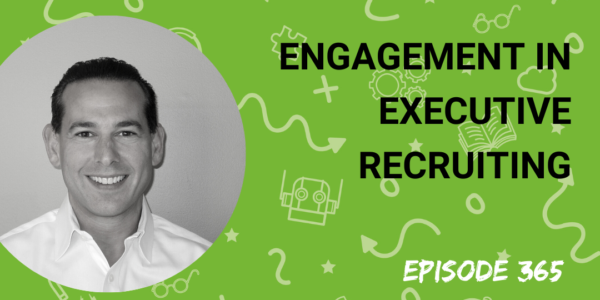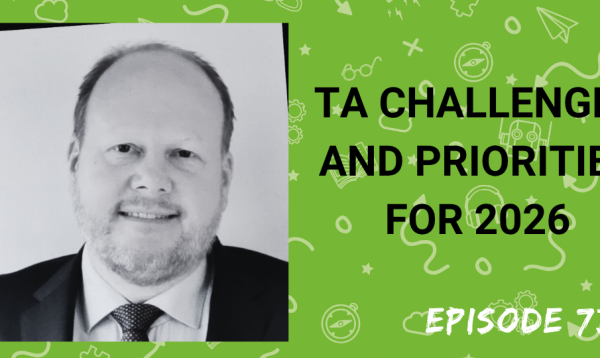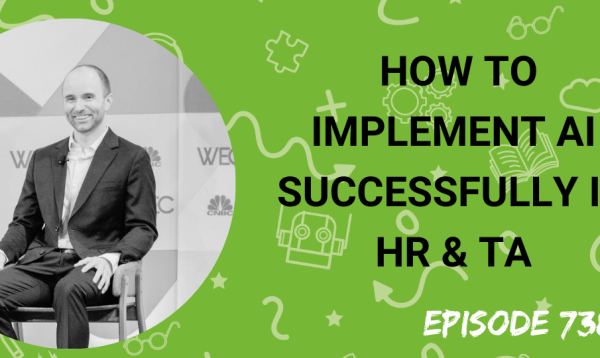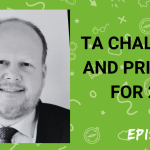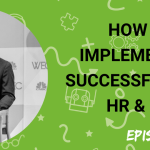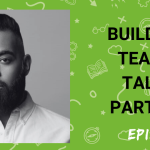One of the topics I get asked to cover frequently is the growth of the corporate executive recruiting function. So with that in mind, I’ve partnered with ESIX, The Executive Search Information Exchange, to bring you a series of three interviews exploring the key trends and issues in corporate executive recruiting.
In the previous two episodes, we looked at the evolution of corporate executive recruiting and what employers should be doing to improve the diversity of their executive teams. For the final interview in this short series, I’m talking to Eric Goldstein, Global Head of Executive Talent Attraction at SAP. We discuss how long term talent engagement is starting to play a more significant role in executive recruiting, the growth of data-driven decision making and what the future might look like.
▪ Topics covered in the interview:
▪ Hyper competitive talent markets
▪ Proactive executive talent engagement
▪ Engaging at scale and offboarding conversations quickly.
▪ Involving hiring managers effectively
▪ Unbiasing assessment
▪ Measuring quality of hire
▪ Onboarding, integration and accountability
▪ Lessons learned around improving diversity.
▪ What is the future of corporate executive recruiting
Listen to this podcast in Apple Podcasts.
Transcription:
Matt Alder [00:00:00]:
Support for this podcast comes from E6. For 25 years, E6 has been the preeminent peer networking and independent information source for corporate executive recruiting leaders worldwide. Featuring members from around 100 of the leading employers in the world, it is the one stop shop for trusted networking with peers, for benchmarking and for team development. Find out more about membership@www.e6.org. That’s WW and E6 is spelled E S I X. Or buy their book Leadership Recruiting on Amazon.
Matt Alder [00:00:58]:
Hi everyone, this is Matt Alder. Welcome to episode 365 of the Recruiting Future podcast. One of the topics I get asked to cover frequently is the growth of the corporate executive recruiting function. So with that in mind, I’ve partnered with e6, the executive search information Exchange, to bring you a series of three interviews exploring the key trends and issues in corporate executive recruiting. In the previous two episodes we looked at the evolution of corporate executive recruiting and what employers should be doing to improve the diversity of their executive teams. For the final interview in this short series, I’m talking to Eric Goldstein, Global Head of Executive Talent Attraction at SAP. We discuss how long term talent engagement is starting to play a bigger role in executive recruiting, the growth of data driven decision making and what the future might look like. Hi Eric and welcome to the podcast.
Eric Goldstein [00:01:57]:
Thanks Matt. It’s a pleasure to be here. Thanks for having me.
Matt Alder [00:02:00]:
An absolute pleasure to have you on the show. Could you just introduce yourself and tell us what you do?
Eric Goldstein [00:02:05]:
Absolutely, would be my pleasure. First, my name is Eric Goldstein and I’ve been in Executive Search for more than 20 years. I’m now the Global Head of Executive Talent Attraction at SAP and I’ve just completed my first three weeks with SAP and had previously been with IBM where I headed the executive recruitment as well as the onboarding and integration function for the enterprise at IBM. Prior to that I ran a practice at Korn Ferry. It was a financial services practice focused on the mid level professional they call professional search. And then prior to that I had a different career in finance and actually started my career as a certified public accountant with Coopers and Lybrand, now known as Price Wardhouse Coopers.
Matt Alder [00:03:03]:
Fantastic stuff and huge congratulations on the new job.
Eric Goldstein [00:03:06]:
Thank you, thank you. So far so good. You know there’s a bit of a learning curve and a knowledge transfer process that’s happening, but it’s really great fun and it’s a Great organization and enterprise, wonderful people.
Matt Alder [00:03:20]:
So obviously we’ve been through and are going through a very disruptive period. How sort of generally has that affected the talent market for the executive function?
Eric Goldstein [00:03:31]:
Well, I think this may be true in other industries as well, but particularly in technology. It’s a hyper competitive marketplace. And unlike some other industries, the global pandemic actually accelerated demand throughout the process as more companies in every industry had to accelerate their digital transformations because everybody was relying on online service delivery. And that really accelerated the process that was going to occur anyway over the next several years, but now is really happening at a super high velocity. So it’s been, I think it just increased the elevated the importance of the function and the mission critical nature of executive search, both from an in house perspective as well as from a outside search firm perspective as well.
Matt Alder [00:04:33]:
Now I know that a big focus for you is long term proactive engagement of talent. Could you tell us a little bit about what you mean by that?
Eric Goldstein [00:04:44]:
Absolutely, absolutely. So I see this as really a top trend in the industry as well as in other industries also as the marketplace becomes more competitive. And there’s a realization that cycle times, which is typically 90 days from beginning commencing a search till the successful candidate accepts his or her offer. It’s traditionally 90 days whether you go to a Korn Ferry or Heydrick or Spencer Stewart or Russell Reynolds, so on and so forth, or from a corporate in house experience as well. And there’s a realization that you’re not always going to get the best talent, both from a technical fit perspective, a cultural fit perspective, as well as a diversity perspective. In that 90 day window of time again, when, when I was recruited to SAP, it was just a moment in time where I was vulnerable to the approach or receptive to the approach is probably a better, better word. And then we obviously went through a process where I became acquainted, you know, with the enterprise. Now if you, if you get in front of that cycle in terms of acquainting passive executive talent with the value proposition of your enterprise in advance of a need or a requisition, you have an opportunity to really shorten the cycle time and improve the scope of candidates that you would consider obviously elevating diversity. Cultural folks, that may be, you know, a better cultural fit as well as a better technical fit. So it’s basically engaging with passive talent in advance of a need and having a meaningful dialogue with that individual that’s programmatic and sustainable and actually introducing that talent to executives so they can get to know the enterprise and the executives and vice Versa. And so when there is a need, there’s already a relationship that’s present.
Matt Alder [00:07:01]:
Talk a little bit more about how that’s scalable and how that might be a kind of an ongoing strategy rather than something just for a particular, one particular role.
Eric Goldstein [00:07:11]:
Absolutely, absolutely. So listen, I think that that’s the biggest challenge, the fact that you can’t court, you know, an unlimited number of senior executive candidates and provide a delightful experience where it’s going to reflect well on your employer brand. So the only way that I figured out to do this is to really be selective into those that you engage with and then have a quick offboarding, you know, program if, if it’s clearly not a potential fit for the future. So it starts with kind of the targeting and those individuals that you targeted and being really precision oriented as best as you can in terms of their background and their experiences. And obviously you can do some anecdotal due diligence on these individuals. And then once you decide who you’re going to reach out to, you really have to have a meaningful dialogue with that individual. It’s not, hey, would you be open to a conversation type of an approach. It’s hey, I’m really impressed with your background. You know, here’s what we’re doing at SAP. Love to trade notes with you. Might there be any interest in, you know, engaging, you know, just having an open ended dialogue, you know, with our executive in this specific area and with no strings, you know, and no attachments. But again, there needs to be a quid pro quo, an exchange of information, market information, obviously nothing that’s sensitive or confidential. But generally there, there needs to be a quid pro quo for a passive candidate who’s quite busy to be able to have the appetite to engage in this dialogue.
Matt Alder [00:09:02]:
Obviously that’s a departure from, as you were saying, the sort of traditional 90 day search and hiring cycle in executive research. How do you manage expectations around that, both in terms of the prospective employee but also the hiring managers as well?
Eric Goldstein [00:09:16]:
Well, I think it’s harder for the hiring managers, believe it or not, from an enablement perspective, Matt. You know, the first challenge really is to define what is expected of the hiring manager in terms of investment of time they are going to be required for this to be successful, to devote the time from their busy schedules to have regular touch points. And you know, and it again, it varies from candidate to candidate, situation to situation, but there needs to be consistency and sustainability because what’s happened in the past, and again this has been a very agile process and We’ve learned in terms of how best to do this and we’re still making adjustments. We certainly haven’t cracked the code yet entirely, but we’re making good incremental progress. So first, having the person agree to meet, but ideally in person, post pandemic, you know, with, with the individual, just have, you know, casual lunch or coffee with that person if they’re local or a video conference if they’re not, and then, you know, agree, you know, if there’s a potential alignment, mutually and it makes sense to carry on the conversation, you know, and there’s no immediate open role that makes sense, agree to have a 30 or 60 day checkpoint, you know, with that individual and from the recruiting standpoint, we’ll give digital nudges to those hiring managers or senior executives to say, hey, you haven’t spoken to this individual, 90 days have passed. It’s probably a good idea just to have a touch based conversation, just to reaffirm the fact that there is interest in maintaining and cultivating the relationship. On the prospect side, it’s a little easier because once they agree to an open ended conversation, as long as it’s understood, they understand that there’s no strings, that confidentiality is completely assured. We’re not going to be checking them out in the marketplace and understanding, so we won’t, in other words, be putting them at risk. So it’s a riskless proposition on their side and there’s, they’re just there with no, you know, with no expectations about a potential job or specific role, but rather for them to learn something about, you know, the enterprise and, you know, what we’re doing and what, you know, we’re, how we’re trying to drive our strategy.
Matt Alder [00:11:55]:
In the other conversations that I’ve been having about executive research, one of the other topics that’s come up is the growth of data driven assessment and selection. Can you sort of talk us through your experience with that and what it entails?
Eric Goldstein [00:12:10]:
Absolutely. I think the holy grail, Matt, is to, you know, find a fully objective, unbiased way to evaluate candidates for selection. As we know, you know, intuition plays a pretty significant role, particularly amongst the recruiters themselves, but also, you know, the hiring stakeholders. You know, everybody seems to know what good looks like, you know, what works best, what type of background works best, what type of traits and competencies the person will bring to the role to ultimately be successful. But nothing is documented and nothing is data driven or data based. So we’re trying to kind of introduce some science to it, have a success profile that’s based on a successful exemplar at the enterprise. Understanding what that individual’s background consists of from an experiential perspective and also the softer skills, you know, what is that personalities. What is the personality of that individual, you know, what traits do they exhibit, what natural tendencies do they exhibit, so on and so forth. So having it be much more scientific in that regard. So we really, there’s alignment amongst all the stakeholders in terms of what good looks like and it’s generally accepted so we can make a decision against that. For specific candidates or prospects in addition to success profiles, you know, the two other tools that we’re using are psychometric assessments and essentially, you know, just getting more insight in terms of their personalities. Now this is not a magic bullet so training and enablement is really important amongst the hiring stakeholders. This will just give us further insight in terms of the person’s natural tendencies and where they’re expending extra energy to be successful versus the success profile. It’s not going to be a determinant ultimately if they’re, if they’re a perfect fit for the role or not. Again, it’s just another data point amongst many. And then lastly a behavioral interview guide. Obviously in most companies as an SAP, you know, there’s several, you know, stakeholders involved in terms of, you know, interviewing for cultural fit, for technical fit, so on and so forth. And you could have, you know, five to seven generally interviewers in a typical process, you certainly don’t want more than, you know, 10 because then the experience is going to be compromised ultimately and there’s going to be a lot of redundancy in the questions. But for the candidate to have the best experience and the hiring stakeholders to glean the most best information, there has to be a really effective feedback loop. So there needs to be, you know, a guide, a behavioral interview guide where you’re avoiding redundancy and questioning and you’re triangulate on any areas of concern and where interviewer, you know, A, you know, has a potential concern in a specific area, he or she is, is communicating that to interviewer B and C, to triangulate on those areas and, and, and conduct more diligence around those areas.
Matt Alder [00:15:42]:
Some of the things that you’re talking about, there are things that have been used in other areas of recruitment perhaps for a while, may maybe not in quite the it that executive recruitment hasn’t done this in the past. If, if you see what I mean.
Eric Goldstein [00:15:55]:
Listen, I think there’s a whole host of reasons but I think that the, the biggest one I think you’ll find if you, if you were to conduct a survey is just capacity and time constraints. I would, you know, a lot of recruiters have a lot of open recs on, on, you know, their play, their collective plates and just don’t have time to put in a standard process, you know, kind of linking all of these elements into one comprehensive program. And you know, historically I think, you know, recruiters like to operate in an autonomous, you know, fashion and you know, and deliver a very bespoke experience depending upon the hiring manager they’re working with as well as the type of position that they’re recruiting for. So I think it’s a combination of those two factors as to why there’s not more standardization and harmonization of these methods and tools.
Matt Alder [00:16:51]:
How are they improving hiring outcomes?
Eric Goldstein [00:16:54]:
Well, essentially that remains to be seen, Matt. So I think it’s going to require a measurement, a look back measurement that not a lot of companies are doing. And I refer to it as a quality of hire measure where you’re looking back six months from the time of placement and understanding whether or not that person first of all is integrating well and is adding value and is meeting his or her, you know, KPIs. And then looking back a year and two years down the line and in a sales capacity, this is kind of easy because it’s really quantitative. You could see if they’re meeting their sales targets and quotas. But for, you know, a general management type of role, you know, it may be a little bit more difficult. And there’s qualitative measures, things like asking the hiring manager if he or she would hire that person again, you know, doing a 360 degree survey, looking at engagement survey, if this person is a people manager and having the right measures to really understanding if this hire had impact. And you know, a measure that I see used quite often is attrition. Is the person, has the person been retained? Is the person still there after two years time or three years time? And to me that’s not, you know, it’s a measure, but it’s not the ideal measure because it doesn’t indicate that this person really has conveyed value, you know, to the enterprise or not. So I like to see kind of outcome oriented measures, you know, things that are objective and easy to measure and really data driven and science based.
Matt Alder [00:18:36]:
And how do you account for the sort of the external variables there? Because people at this level, I’m sure their performance is particularly susceptible to the support they get from the enterprise, the dynamics of the market, all those kind of things. How do you take that into account?
Eric Goldstein [00:18:53]:
It’s really difficult because it does take a village. So the, the executive recruiter that, you know, ultimately identifies, assesses and recruits the successful candidate certainly doesn’t have influence over the person’s ability to be successful in an enterprise. Like you said, that is a function of, you know, market dynamics. It’s a function of are they getting the proper support from the hiring, from, from their teams and, and a direct manager. So I think there’s a lot of external forces at play like you suggest. So my advice is reminding everybody that everybody is accountable for their successful hire, including the onboarding and integration function. And they need to set the person up for success from the get go. Really help the person integrate, you know, well into the organization, help them feel supported and make it part of the KPIs of, of the manager and others to ensure the success of that individual. So I’m a big fan of documenting hiring decisions. You know, so, you know, having a, having a, you know, a document that shows that, hey, I voted to hire this person and I am committed to person’s success. So if the derail or something, there’s a sense of accountability there and it’s not just the fault of the recruiter because I’ve heard too many times, oh, it’s your fault that the person wasn’t successful and didn’t integrate into the company successfully, so on and so forth. So I think it’s really important to have to remind everybody during the enablement period that it’s everybody’s collective responsibility to ensure the success of the hire.
Matt Alder [00:20:53]:
A bit earlier in the conversation you talked about improving diversity and obviously that’s, that’s been a challenge for, for a while at the executive level. What’s the solution to the challenge when it comes to attracting and hiring more diverse executive talent?
Eric Goldstein [00:21:10]:
I, you know, Matt, I don’t claim to know the, the absolute solution. There certainly is no magic bullet and it is a hyper competitive marketplace for diverse talent, you know, globally. From a gender diversity perspective, you know, I think from a, in the US in the Americas, you know, from an underrepresented minority perspective, in the uk, from a BAME perspective. So everybody defines, you know, diverse hires, you know, in a different way. But gender diversity seems to be the universal accepted one across the globe. But again, there’s no magic bullet. But there are some best practices and I think the first best practice is really to try to pipeline that talent, start early conversations with that talent. As we were talking about at the outset of our conversation Also being really empathetic to that individual. First of all, they’re being called upon by so many companies now with what’s going on in the US and the hunger and the appetite for the diverse talent to achieve their business objectives. Everybody, there’s a, there’s a, there’s a wholesale recognition that it does require the most diverse talent to be successful. So everybody is chasing that talent. And you don’t want to leave the individual at the person that you’re, you’re calling on that person because of his or because, because of their gender or ethnicity or race, but you’re calling on them because you’re interested in their skills and their competencies. And I think it’s really, really important that that comes across really authentically in the approach as well as the subsequent process and conversations. And then once the person enters into an interviewing process, I think it’s really important that there’d be a diverse interviewer panel. Whether or not you’re doing sequential interviews or, you know, or having, you know, a panel collectively having, you know, people that are, you know, female on or diverse, you know, ethnically or racially is really, really important that they see there are people that look like them that, you know, represented on as decision makers, you know, in the organization. And I can’t emphasize enough, you can’t lead this exercise by spreadsheet. I’ve seen it done in the past where they go to the most granular level, you know, in a division without regard, you know, to whether or not there is a diverse constituency in a very, in a highly technical area. You know, if there’s no availability of talent, you’re, you know, you’re not going to be fishing in a very in a pond that’s, that has, you know, a lot of optionality in that talent pool. And the likelihood of you coming to a diverse outcome is very low. So you know, obviously you’ve got, I think you should be really thoughtful and systematic and leverage talent insights in understanding where the most diverse talent pools reside and try to exploit those talent pools.
Matt Alder [00:24:31]:
Are there any sort of lessons you’ve learned about, you know, tactics that don’t work or that people should avoid?
Eric Goldstein [00:24:37]:
So Matt, in terms of, you know, lessons learned as it relates to diverse recruiting, I think it pays not to be closed minded. You know, again, if you’re going into an area and let’s just by example in automotive or industrial, you’re not going to find, unfortunately it’s just the market dynamics, a plethora of female talent at the senior executive level. And again this is just what I’ve found and I’m not stating that’s the absolute fact. However, I think it really, really pays to be cognizant of that reality and help it inform your development plans for more junior talent and try to grow that talent in house rather than beat your head against the wall and trying to recruit for that talent on the outside. Again, managing by spreadsheet I think is a pitfall that many fall into. And you know, recognizing that you really need to take a holistic view toward diversity and, you know, really try to find those areas, you know, where you’re going to gain the traction. It’s not a short term gratification exercise. It’s something that requires commitment and investment to the long term in terms of both cultivating talent on, on the in house side as well as fishing in the ponds where there’s greater volume of talent, you know, in certain areas from a diversity standpoint relative to others.
Matt Alder [00:26:27]:
Final question. What’s on your radar for the next 12 to 18 months? What do you think the future is going to look like?
Eric Goldstein [00:26:33]:
I think the, the, the competition for talent at the executive levels is going to intensify. So I think it’s going to require, I think that’s first of all going to elevate the stature of the corporate in house executive recruitment function as well as the onboarding and integration function. So I think you’re going to see more resources and investment be allocated toward these functions. Where historically, you know, it was kind of a bolt on to talent acquisition. I think there’s going to be a recognition that this is the key to unlocking a competitive advantage and being competitive. Because again, the, when you refresh talent from the external marketplace, you infuse a different way of thinking, different perspectives. Someone that’s going to disrupt the status quo, particularly if you have long tenured individuals in your enterprise and you’re going through a transformation of sorts and it requires new thinking. So I think you’re really going to see that. So I think you’re already starting to see recruiters being poached across the board because of that recognition and I think that’s going to intensify. And then again, the proactive, kind of predictive, working hand in glove with executive succession functions is going to be much more of the norm. Rather than this reactive, transactional, wreck by wreck type of approach that has been the traditional way of thinking as it relates to executive recruitment in the past. I think increasingly it’s going to be much more predictive and proactive in nature.
Matt Alder [00:28:35]:
Eric thank you very much for talking to me.
Eric Goldstein [00:28:37]:
It’s been my pleasure, Matt. Thanks for having me.
Matt Alder [00:28:40]:
My thanks to Eric. If you want to find out more about membership of E6, you can contact Simon Mullins, their CEO, directly via email. His email address is Simon6.org you can subscribe to this podcast in Apple Podcasts, on Spotify or via your podcasting app of choice. Please also follow the show on Instagram. You can find us by searching for Recruiting Future. You can search all the past episodes@recruitingfuture.com on that site. You can also subscribe to the mailing list to get the inside track about everything that’s coming up on the show. Thanks very much for listening. I’ll be back next time and I hope you’ll join me.

